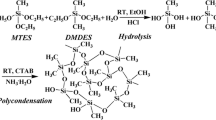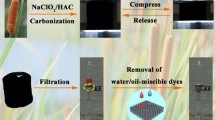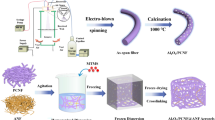Abstract
Design readily available and inexpensive aerogels as potential sorbent materials for oil–water separation is extremely significant because of the increasing discharge of domestic oil pollution. Hereby, a novel superhydrophobic indole-based hemiaminal aerogel (PCINA) without any post-surface treatment was fabricated by a facile, simple and mild method via sol–gel technology followed by freeze-drying. The as-obtained indole-based hemiaminal aerogel exhibited high absorption capacity for varieties of oils and organic solvents. In addition, the separation efficiency of oil–water mixture was as high as 99.8%, even the separation efficiency of emulsion could achieve to 98.2%. More excitingly, the indole-based hemiaminal aerogel PCINA possessed repeatability and regeneration due to the feasible desorption and rapid degradation, suggesting that the green and renewable aerogel was a promising material for the treatment of oil contaminants in different fields.
Graphical abstract









Similar content being viewed by others
Data availability
Some or all data that support the findings of this study are available from the corresponding author upon reasonable request.
References
Chang J, Ong C, Shi Y, Yuan J, Ahmed Z, Wang P (2021) Smart sand by surface engineering: toward controllable oil/water separation. Ind Eng Chem Res 60:9475–9481. https://doi.org/10.1021/acs.iecr.1c01450
Liu C, Peng Y, Huang C, Ning Y, Shang J, Li Y (2022) Bioinspired superhydrophobic/superhydrophilic janus copper foam for on-demand oil/water separation. ACS Appl Mater Interfaces 14:11981–11988. https://doi.org/10.1021/acsami.2c00585
Bai Z, Jia K, Liu C et al (2021) A solvent regulated hydrogen bond crosslinking strategy to prepare robust hydrogel paint for oil/water separation. Adv Funct Mater 31:2104701. https://doi.org/10.1002/adfm.202104701
Huang J, Lu Z, Li J, Jia F, Wang Y, Hua L (2023) In situ growth of ZIF-8 onto aramid nanofiber composite aerogel for efficient removal of pollutants in water. ACS Appl Polym Mater 5:1606–1612. https://doi.org/10.1021/acsapm.2c02110
Li H, Yang H, Shu Y, Li C, Li B, Xiao W, Liao X (2023) Stainless steel screen modified with renatured xerogel for efficient and highly stable oil/water separation via gravity. Langmuir 39:3131–3141. https://doi.org/10.1021/acs.langmuir.2c03307
Grigorenko AN, Roberts NW, Dickinson MR, Zhang Y (2008) Nanometric optical tweezers based on nanostructured substrates. Nat Photonics 2:365–370. https://doi.org/10.1038/nphoton.2008.78
Lin Q, Mendelssohn IA, Bryner NP, Walton WD (2005) In-situ burning of oil in coastal marshes. 1. Vegetation recovery and soil temperature as a function of water depth, oil type, and marsh type. Environ Sci Technol 39:1848–1854. https://doi.org/10.1021/es049063y
Hazen TC, Dubinsky EA, DeSantis TZ et al (2010) Deep-sea oil plume enriches indigenous oil-degrading bacteria. Science 330:204–208. https://doi.org/10.1126/science.1195979
Prince RC (2015) Oil spill dispersants: boon or bane? Environ Sci Technol 49:6376–6384. https://doi.org/10.1021/acs.est.5b00961
Li L, Zhang J, Wang A (2018) Removal of organic pollutants from water using superwetting materials. Chem Rec 18:118–136. https://doi.org/10.1002/tcr.201700029
Broje V, Keller AA (2006) Improved mechanical oil spill recovery using an optimized geometry for the skimmer surface. Environ Sci Technol 40:7914–7918. https://doi.org/10.1021/es061842m
Li R, Rao L, Zhang J et al (2021) Novel in-situ electroflotation driven by hydrogen evolution reaction (HER) with polypyrrole (PPy)-Ni-modified fabric membrane for efficient oil/water separation. J Membr Sci 635:119502. https://doi.org/10.1016/j.memsci.2021.119502
Qiu L, Sun Y, Guo Z (2020) Designing novel superwetting surfaces for high-efficiency oil-water separation: design principles, opportunities, trends and challenges. J Mater Chem A 8:16831–16853. https://doi.org/10.1039/D0TA02997A
Wang Y, Yang H, Chen Z et al (2018) Recyclable oil-absorption foams via secondary phase separation. ACS Sustain Chem Eng 6:13834–13843. https://doi.org/10.1021/acssuschemeng.8b01950
Qiu S, Li Y, Li G, Zhang Z, Li Y, Wu T (2019) Robust superhydrophobic sepiolite-coated polyurethane sponge for highly efficient and recyclable oil absorption. ACS Sustain Chem Eng 7:5560–5567. https://doi.org/10.1021/acssuschemeng.9b00098
Sakthivel T, Reid DL, Goldstein I, Hench L, Seal S (2013) Hydrophobic high surface area zeolites derived from fly ash for oil spill remediation. Environ Sci Technol 47:5843–5850. https://doi.org/10.1021/es3048174
Choi HM, Cloud RM (1992) Natural sorbents in oil spill cleanup. Environ Sci Technol 26:772–776. https://doi.org/10.1021/es00028a016
Tang Y, Zheng Q, Chen B, Ma Z, Gong S (2017) A new class of flexible nanogenerators consisting of porous aerogel films driven by mechanoradicals. Nano Energy 38:401–411. https://doi.org/10.1016/j.nanoen.2017.06.022
Zhao Y, Shen L, Yuan Y, Xiao L, Cai J, Lu Z, Hou L (2023) Preparation of porous poly(4-tert-butylstyrene) based monoliths with high efficiency for oil-water separation via high internal phase emulsion template. J Appl Polym Sci 140:e53801. https://doi.org/10.1002/app.53801
Liu T, Li D, Huang K, Tan S, Huang L (2023) Preparation and water/oil separation of super-hydrophobic biomass adsorbent based on three-dimensional graphene aerogel. J Chem Technol Biotechnol 98:744–755. https://doi.org/10.1002/jctb.7279
Ma W, Lu T, Cao W, Xiong R, Huang C (2023) Bioinspired nanofibrous aerogel with vertically aligned channels for efficient water purification and salt-rejecting solar desalination. Adv Funct Mater 2023:2214157. https://doi.org/10.1002/adfm.202214157
Yang Y, Chen X, Li Y, Yin Z, Bao M (2021) Construction of a superhydrophobic sodium alginate aerogel for efficient oil absorption and emulsion separation. Langmuir 37:882–893. https://doi.org/10.1021/acs.langmuir.0c03229
Zhuo L, Ma C, Xie F, Chen S, Lu Z (2020) Methylcellulose strengthened polyimide aerogels with excellent oil/water separation performance. Cellulose 27:7677–7689. https://doi.org/10.1007/s10570-020-03311-6
Lin B, Wang Z, Zhu Q, Binti Hamzah WN, Yao Z, Cao K (2020) Aerogels for the separation of asphalt-containing oil-water mixtures and the effect of asphalt stabilizer. RSC Adv 10:24840–24846. https://doi.org/10.1039/D0RA00544D
Ieamviteevanich P, Palaporn D, Chanlek N, Poo-arporn Y, Mongkolthanaruk W, Eichhorn SJ, Pinitsoontorn S (2020) Carbon nanofiber aerogel/magnetic core-shell nanoparticle composites as recyclable oil sorbents. ACS Appl Nano Mater 3:3939–3950. https://doi.org/10.1021/acsanm.0c00818
Jiang J, Zhang Q, Zhan X, Chen F (2019) A multifunctional gelatin-based aerogel with superior pollutants adsorption, oil/water separation and photocatalytic properties. Chem Eng J 358:1539–1551. https://doi.org/10.1016/j.cej.2018.10.144
Bai X, Yuan Z, Lu C, Zhan H, Ge W, Li W, Liu Y (2023) Recent advances in superwetting materials for separation of oil/water mixtures. Nanoscale 15:5139–5157. https://doi.org/10.1039/D2NR07088J
Chhajed M, Verma C, Gupta P, Maji PK (2023) Multifunctional esterified nanocellulose aerogel: impact of fatty chain length on oil/water separation and thermal insulation. Cellulose 30:1717–1739. https://doi.org/10.1007/s10570-022-04993-w
Fox CH, Hurrne GM, Wojtecki RJ et al (2015) Supramolecular motifs in dynamic covalent PEG-hemiaminal organogels. Nat Commun 6:7417. https://doi.org/10.1038/ncomms8417
Li Z, Qiu J, Yuan S, Luo Q, Pei C (2017) Rapidly degradable and sustainable polyhemiaminal aerogels for self-driven efficient separation of oil/water mixture. Ind Eng Chem Res 56:6508–6514. https://doi.org/10.1021/acs.iecr.7b00312
Guan X, Ma Y, Yang L et al (2020) Unprecedented toughening high-performance polyhexahydrotriazines constructed by incorporating point-face cation-π interactions in covalently crosslinked networks and the visual detection of tensile strength. Chem Commun 56:1054–1057. https://doi.org/10.1039/C9CC08603J
Wang Y, Zhang L, Yang L, Chang G (2020) An indole-based smart aerogel for simultaneous visual detection and removal of trinitrotoluene in water via synergistic effect of dipole-π and donor-acceptor interactions. Chem Eng J 384:123358. https://doi.org/10.1016/j.cej.2019.123358
Li Y, Du M, Yang L et al (2021) Hydrophilic domains compose of interlocking cation-π blocks for constructing hard actuator with robustness and rapid humidity responsiveness. Chem Eng J 414:128820. https://doi.org/10.1016/j.cej.2021.128820
Wang Y, Liu D, Zheng Q et al (2014) Disulfide bond bridge insertion turns hydrophobic anticancer prodrugs into self-assembled nanomedicines. Nano Lett 14:5577–5583
Briggs D, Beamson G (1993) XPS studies of the oxygen 1s and 2s levels in a wide range of functional polymers. Anal Chem 65:1517–1523. https://doi.org/10.1021/ac00059a006
Cheng Y, Guan S, Li D, Zhu J, Zeng B (2019) Robust and durable superhydrophobic cotton fabrics via a one-step solvothermal method for efficient oil/water separation. Cellulose 26:2861–2872. https://doi.org/10.1007/s10570-019-02267-6
Meng X, Dong Y, Zhao Y, Liang L (2020) Preparation and modification of cellulose sponge and application of oil/water separation. RSC Adv 10:41713–41719. https://doi.org/10.1039/D0RA07910C
Jha P, Koiry SP, Sridevi C, Putta V, Gupta D, Chauhan AK (2020) A strategy towards the synthesis of superhydrophobic/superoleophilic non-fluorinated polypyrrole nanotubes for oil-water separation. RSC Adv 10:33747–33752. https://doi.org/10.1039/D0RA06409B
Li X, Zhang T, Xu Z, Chi H, Wu Z, Zhao Y (2020) Amphiphobic polyHIPEs with pH-triggered transition to hydrophilicity-oleophobicity for the controlled removal of water from oil-water mixtures. Polym Chem 11:6935–6943. https://doi.org/10.1039/D0PY01144D
Wang B, Yang X, Sha D, Shi K, Xu J, Ji X (2020) Silane functionalized polyvinyl-alcohol formaldehyde sponges on fast oil absorption. ACS Appl Polym Mater 2:5309–5317. https://doi.org/10.1021/acsapm.0c01052
Zhu C, Jiang W, Hu J, Sun P, Li A, Zhang Q (2020) Polylactic acid nonwoven fabric surface modified with stereocomplex crystals for recyclable use in oil/water separation. ACS Appl Polym Mater 2:2509–2516. https://doi.org/10.1021/acsapm.9b01197
Guo Z, Long B, Gao S et al (2021) Carbon nanofiber based superhydrophobic foam composite for high performance oil/water separation. J Hazard Mater 402:123838. https://doi.org/10.1016/j.jhazmat.2020.123838
Han L, Wu W, Huang Z et al (2021) Preparation and characterization of a novel fluorine-free and pH-sensitive hydrophobic porous diatomite ceramic as highly efficient sorbent for oil-water separation. Sep Purif Technol 254:117620. https://doi.org/10.1016/j.seppur.2020.117620
Chang G, Wang Y, Wang C, Li Y, Xu Y, Yang L (2018) A recyclable hydroxyl functionalized polyindole hydrogel for sodium hydroxide extraction via the synergistic effect of cation-π interactions and hydrogen bonding. Chem Commun 54:9785–9788. https://doi.org/10.1039/C8CC05819A
He C, Huang J, Li S, Meng K, Zhang L, Chen Z, Lai Y (2018) Mechanically resistant and sustainable cellulose-based composite aerogels with excellent flame retardant, sound-absorption, and superantiwetting ability for advanced engineering materials. ACS Sustain Chem Eng 6:927–936. https://doi.org/10.1021/acssuschemeng.7b03281
Zhu T, Cheng Y, Huang J et al (2020) A transparent superhydrophobic coating with mechanochemical robustness for anti-icing, photocatalysis and self-cleaning. Chem Eng J 399:125746. https://doi.org/10.1016/j.cej.2020.125746
Li J, Yang L, Liu H, Li G, Li R, Cao Y, Zeng H (2020) Simple preparation method for hydrophilic/oleophobic coatings. ACS Appl Mater Interfaces 12:45266–45273. https://doi.org/10.1021/acsami.0c11596
Bai X, Shen Y, Tian H, Yang Y, Feng H, Li J (2019) Facile fabrication of superhydrophobic wood slice for effective water-in-oil emulsion separation. Sep Purif Technol 210:402–408. https://doi.org/10.1016/j.seppur.2018.08.010
Acknowledgements
This work was financially supported by the National Natural Science Foundation of China (21973076 and 22006122), the Project of the Central-Guided Local Science and Technology Development (2022ZYD0025), the Sichuan Talent Fund for Distinguished Young Scholars (2021JDJQ0033), the Applied Basic Research Programs of Sichuan Science and Technology Department (2021YJ0059), the Natural Science Foundation of Sichuan Province (2022NSFSC0310), and the Innovation and Development Fund of China Academy of Engineering Physics (CX20210039).
Author information
Authors and Affiliations
Contributions
RG and YZ performed the characterization analysis and application experiments. RG and RY synthesized the samples. YH and GC conceived the study. RG, LY, LW and GC wrote the manuscript.
Corresponding authors
Ethics declarations
Conflict of interest
There are no conflicts to declare.
Ethical approval
Not applicable.
Additional information
Handling Editor: Maude Jimenez.
Publisher's Note
Springer Nature remains neutral with regard to jurisdictional claims in published maps and institutional affiliations.
Supplementary Information
Below is the link to the electronic supplementary material.
Rights and permissions
Springer Nature or its licensor (e.g. a society or other partner) holds exclusive rights to this article under a publishing agreement with the author(s) or other rightsholder(s); author self-archiving of the accepted manuscript version of this article is solely governed by the terms of such publishing agreement and applicable law.
About this article
Cite this article
Guo, R., Zhang, Y., Wang, L. et al. Facile construction of a degradable and renewable superhydrophobic indole-based hemiaminal aerogel for efficient oil–water separation. J Mater Sci 58, 8346–8358 (2023). https://doi.org/10.1007/s10853-023-08564-7
Received:
Accepted:
Published:
Issue Date:
DOI: https://doi.org/10.1007/s10853-023-08564-7




